This article on growing spinach is part of our Green of the Month series. To read the rest of the articles in the series, click here.
Spinach is one of my favorite leafy greens. Every time I see those plastic boxes of it at the grocery store in the middle of our 90ºF summers, I am so tempted to buy one (or 10).
Then I remind myself of all the other incredible leafy greens that grow so well even in heat, in my Southern garden. With thoughts of oak leaf lettuce and sweet potato greens to tide me over, I manage to exercise some restraint.
Read More: “Sweet Potato Vines: How to Grow This Antioxidant Powerhouse”
Read More: “Heat? Drought? Delicious Oak Leaf Lettuce Thrives Anyway!”
Spinach is a cold-season crop. And frankly, it’s an extremely marginal crop in warm Southern regions. Yet, if you love it as much as I do, you find ways to grow it.
The Goods on Spinach
I probably don’t have to sell you on the idea of growing and using spinach. It is literally the most popular leafy green and “all-around useful vegetable” on the planet. However, just in case you are a latecomer to the pleasure of this potent little powerhouse, let me give you a quick rundown of the goods on spinach.
#1. Extremely Versatile
Raw spinach leaves makes an incredible salad or salad ingredient. Older spinach leaves are great for canning and turning into creamed spinach to enjoy with fall or winter dinners.
Wilted spinach is pretty much a staple feature on just about any fine dining restaurant around. And for good reason!
It wilts in seconds, tastes amazing with just a sprinkle of salt and pepper, and is a perfect complement to fish, meat, or vegetarian main course alternatives.
#2. Even Kids Eat It!
Thanks to the enduring popularity of the spinach-eating (and probably politically inappropriate) near-superhero Popeye the Sailor Man, spinach is even a winner with kids.
Even if they aren’t likely to grow ginormous biceps by popping open and slurping up an entire can of those green goodies, spinach can, indeed, help make them mighty.
#3. It’s Incredibly Nutritious
The thing that really makes spinach stand out as a healthy green is that the vitamins and minerals contained in its chlorophyll-rich leaves are highly digestible by humans.
Some greens, like kale, contain nutrients that aren’t always accessible by our human digestive systems. Spinach, though, is constituted in such a way that you don’t have to be a goat to fully metabolize all that good stuff.
So, when you read about how a 1 cup serving of raw spinach has nearly 1000% of your vitamin K; over 100% of your vitamin A; about two-thirds of your daily manganese and folate; and roughly one-third of your daily dose of magnesium, iron, copper, and vitamin B2 (and more), that’s not just scientific analysis. Your body actually recognizes and uses a significant portion of all that nutrition.
#4. It’s Palatable
When you raise livestock, you start to see the term “palatability” in reference to your supplemental feed supply. What this means is that something has been added to your healthy feed so that animals will actually eat it instead of turning their noses up at it.
Well, we all know we should eat more leafy greens for good health. Yet, many of us fail to meet our daily quotas of green matter. Or, we have to slather our greens in other, more palatable foods like butter or bacon to get them down.
Spinach, though, is actually palatable all on its own. Most people can even enjoy it without salad dressing or with just a splash of vinegar. This means that the 41 calories that come in a cup of spinach might actually be all you need to consume to enjoy eating your greens!
Now, I can think of about a hundred recipes that benefit from the addition of spinach. But I am something of a food purist. I like simple recipes that work with almost no effort. So, here’s my favorite way to eat spinach:
Recipe: Shiitake Mushroom With Wilted Spinach
- Warm up a cast iron pan and toss in a tiny pat of butter.
- Chop up ¼ pound of shiitake mushrooms, and sauté until tender.
- Turn off the heat and toss in a cup of spinach.
- Close the lid and let the spinach wilt for 2 minutes.
- Open the lid, add salt and pepper to taste, and stir.
- Serve with your favorite main course.
So simple! So savory! So spinach-licious!
If you want to get wild and crazy, add some minced garlic while you are sautéing the mushrooms. But even that’s not necessary for this fabulously easy side dish.
A Few Cautions About Spinach
Now that I’ve just talked you into becoming a spinach fanatic, you know there’s got to be a downside, right? Well, there is! Kind of . . . .
#1. Too Much of a Good Thing
All those incredible nutrients in spinach can sometimes be too much of a good thing. For example, all that oxalic acid that contributes to the high vitamin content in the first place can have a negative impact on some people—particularly those with kidney and liver problems (or at risk for them).
Additionally, used in excess, oxalic acid can actually start to prevent your body from absorbing all those great minerals by binding with them and making them insoluble by water or fat. As a result, some overusers of spinach can end up iron or calcium deficient.1)https://www.livestrong.com/article/411787-side-effects-of-spinach
Then, there’s the D word. You know . . . that not-so-pleasurable experience that often sends you racing for the restroom when you’ve had too much of the F word (as in fiber).
Spinach, as with all leafy greens (and just about everything else you eat), should be enjoyed in moderation as part of a balanced diet. So, no popping back cans of this delicious green to make your biceps bulge. Instead, enjoy a couple of small servings a week for best results.
#2. It’s Hard to Grow
If you live in Northern climates, and have great loamy soil, you might disagree with me on this point. But here in North Carolina, with our clay soils (even the heavily amended kind), growing spinach is a challenge. We are pretty much limited to fall planting for a late winter, into early spring, harvest.
#3. It’s in the Beet Family
Spinach is part of the beet family. So, if you are growing lots of chard and beets, make sure to rotate your spinach when you rotate those two tasty garden favorites to avoid depleting soil and soliciting pest problems.
Growing Spinach
With the good, the bad, and the unspeakable D-word behind us, let’s get to growing some spinach at home!
Soil Preparation
Spinach needs good soil. There’s no way around this.
Double dig, build square foot gardening beds, sheet mulch, or go heavy on the well-aged compost wherever you plan to plant this glorious green. Just make sure your soil is loose, fertile, and ready for planting before you try to grow spinach.
Boron
Spinach also needs sufficient boron for good growth. According to the growing guide from NC State Extension2)https://content.ces.ncsu.edu/spinach:
Boron-deficient spinach has dark roots and numerous small, flattened, yellow leaves and is generally stunted. To prevent the issue, apply 1 pound of boron (10 pounds/acre of borax) prior to seeding. Note: Use boron only if needed and only in the amounts mentioned above.
Fertilizer
In my experience, spinach does need fertilizer and not just compost for good production. I am not a fan of using prepackaged fertilizers, but if you are so inclined, use about 3 pounds of 10-10-10 per 100 square feet for good production.
Personally, though, I add about an inch of worm castings to my spinach bed before planting. Additionally, I use one of these two methods to ensure the fertility of my spinach patches throughout their long growing season.
Method #1: The Bucket Method
I like to drill a hole in the bottom of a 5-gallon bucket, fill it with fresh chicken manure and straw, and put it in my garden beds. Then, I plant my spinach around the bucket.
When I water my beds, I also water the compost bucket so that some of that fertilizer from the chicken manure leaches down into the soil for the spinach roots to access. I refill the bucket as necessary during the growing season.
Method 2: Chicken Manure Trench
My second method for fertilizing spinach is to make a 4-inch-deep x 4-inch-wide trench down the center of my beds. Then I plant my spinach about 6 inches from the edge of the trench.
I fill the trench with about 2 inches of fresh chicken manure or 3 inches of goat manure. Then I cover the manure with soil, bringing the trench back up to level.
In this case, I don’t water the trench unless the soil starts to dry out. All the life in my soil decomposes that stuff in the ground and spreads it around the root zones of the spinach. Also, because that area tends to be a bit warmer as it composts, the spinach roots often reach toward it for warmth and nutrients.
Seed Starting
Spinach can be slow to germinate relative to other greens. It is also picky about soil temperatures. I usually can’t get it to germinate outside until late September in my area, when soil temperatures drop into the low 70s.
If you want early germination, and you live in warm areas, you may need to start in an air-conditioned space and transplant outdoors once soil temperatures have cooled. For transplanting, use deep seed-starting trays and transplant carefully to ensure you don’t damage the long taproot on your spinach starts.
Soaking seeds for a few hours before planting can improve germination rates. Plant at about 1/4″ deep. Also, keep soil consistently moist for best results. During low-humidity periods, I often water my spinach twice a day to ensure good germination rates.
Spinach seeds seem to like company. I like to start 4-5 together in a hole; then I thin to 1 plant after they develop their first 2 true leaves.
As long as you have sufficient soil fertility, you can space your spinach plants at about 8 inches apart. General recommendations usually call for about 12 inches apart, though.
Young Plant Care
Since spinach is a cold-season plant, it is generally planted in the shoulder seasons when day length is either increasing or declining. This means that spinach receives less sun than other plants and tends to grow slower as a result.
Water Regularly
Your spinach plants need to babied a bit longer that long-day-grown vegetables. Water as needed until plants have sufficient root growth so that you can cut down to once-a-week waterings (when rain is insufficient).
Mulch
Mulching around spinach plants will cut down on the frequency of watering. Also, using dark mulch like double-shred hardwood will warm the soil faster on sunny days and keep the soil warmer longer to hep with root development.
Cold Protection
Established spinach can withstand frosts and even freezing temperatures. However, young plants are not as hardy. Using cold frames or floating row covers to protect young plants may be necessary in cooler climates.
Mature Plant Care and Harvesting
Once established, spinach can be pretty hardy. During periods of extended cold that’s hovering near freezing, the plant can even go dormant and then begin growing again when the weather warms up.
In fact, in my USDA Plant Hardiness Zone 7a, we actually plant in late summer and don’t really get to do much harvesting until spring of the following year. Plants will establish deep roots in fall and then start growing on warm days in late winter, becoming really productive in early spring.
Protecting plants from excessive wind and making sure the soil is continuously moist will improve leaf production.
To harvest the entire plant, you can use a knife to cut spinach at the crown. In cooler climates, you can get multiple cuttings off the same crown. Or, you can use your spinach as a “come and cut” plant by harvesting the older leaves and allowing the plant to grow new replacement leaves before harvesting again.
As soon as soil temperatures start to go up, spinach bolts, so using shade cover on sunny days in early spring can help regulate soil temperatures and extend the growing season for your spinach.
Varieties of Spinach
Bloomsdale Long-Standing is the most common variety of spinach used by home gardeners. It’s suitable for a number of different climates and soil types and has a fair amount of disease resistance.
There are a number of other heirloom varieties available. However, at least in my area, none have proven suitable for our short fall and spring cool periods.
Generally, I only use heirloom seeds. But with spinach, depending on your climate, using hybrid seeds adapted for your conditions may be your only viable choice for getting good production. Talk to gardeners near you to find out which varieties have worked well for them.
Unconventional Growing Tips for Adventure Gardeners
I have not quite perfected this method yet, but I have started trying to grow spinach in partial shade around a kiddie pool.
My theory is that the water in the kiddie pool and the shade provide a kind of cooling microclimate that will help extend my spinach-growing season by a couple of months so I can get better production.
I probably would have had some good success using this method this year. Unfortunately, we got some monumental rains that flooded the area I was using for this purpose and caused the roots of the plants to rot.
If you are as crazy about spinach as I am and are willing to take a risk, this might be a way to extend your season—if you can avoid flooding your plants at exactly the wrong times!
Tell Us What You Think!
For all you spinach growers and lovers out there, please share your tips and recipes with our Community! We’d love to hear from you!

Tasha Greer is a regular contributor to The Grow Network and has cowritten several e-books with Marjory Wildcraft. The author of “Grow Your Own Spices” (December 2020), she also blogs for MorningChores.com and Mother Earth News. For more tips on homesteading and herb and spice gardening, follow Tasha at Simplestead.com.
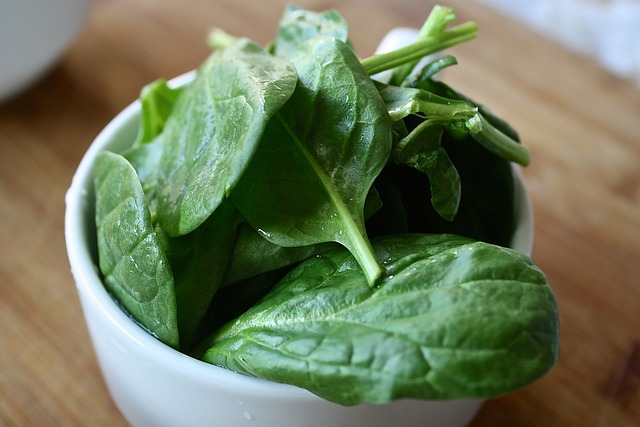
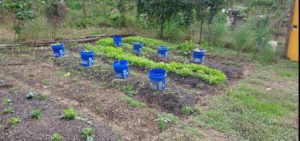
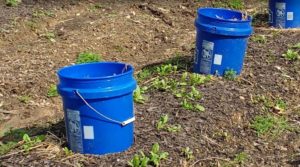
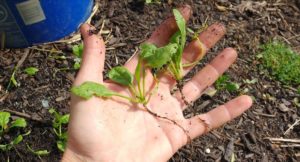
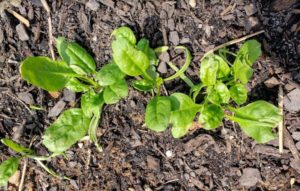








COMMENTS(4)
Great topic as I am a spinach fan and use it solely as a green in my salads. I’ve had spinach produce all winter if I keep it covered with snow after picking some leaves for salads.
We don’t get much snow cover here – just lots of cold and wind. But using snow to insulate your spinach is an awesome idea. Also, snow is a great source of nitrogen for your spinach too! Thanks for reading!
Great article! I love spinach (and Popeye!) Any advice for growing spinach in VA with limited space? Can it be grown in containers outside? I live on a farm but in an apt. with limited space and neighbors. But I do have some porch space and some limited side yard space but it is shaded half of the day. I have been trying to figure out what I can grow without much to work with. I also work long hours and am a single mom so I have little time. Tomatoes have been all I have done since living here simply because I know they work & are easy. Thanks!
Love spinach. Cannot wait to harvest my own.